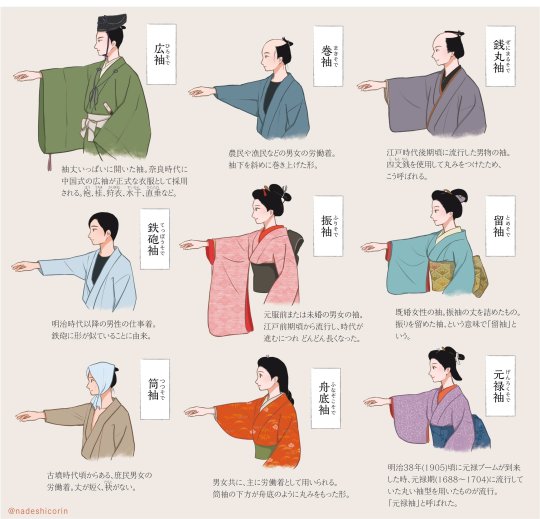#Zenimarusode
Photo

Quick sleeves style overview, a handy reference chart by Edo-lover Nadeshico Rin :D You can see from left to right, top to bottom:
Hirosode 広袖 - wide sleeves opened on their full lenght (cuff sometimes closed by drawstring). Inspired by Chinese attires, they started to be used by Japanese nobles during Nara era. Those can be found on court attires such as hô 袍, kariginu 狩衣, suikan 水干, hitatare 直垂, etc
Makisode 巻袖 - work clothes used by men and women alike, worn by farmers, fishermen etc. Sleeves are cut diagonally offering freedom of mouvement.
Zenimarusode 銭丸袖 - lit. “round coin” sleeve, a man style popular in second half of Edo period. Name come from the fact round part of the sleeves was made using shimonsen coins.
Tetsubôsode 鉄砲袖 - “gun barrel” sleeve, work clothes worn by men from Meiji period. Note the underarm gusset for freedom of mouvement.
Furisode 振袖 - long dangling sleeves, which became popular in early Edo period and got longer and longer as time went by. In the past, those sleeves were worn both by girls and boys (before their mariage/genpuku ceremonies). This style is now mainly worn by girls+young women.
Tomesode 留袖 - “cut” sleeves, style worn by married women during Edo. Name comes from the fact it was customary to shorten one’s furisode sleeves when married. This style is now the sleeve style found on women kimono
Tsutsusode 筒袖 - tight tubular sleeves, work clothes worn by men and women alike since Kofun period. Tightness means there is no tamoto 袂 (”pocket”/drop part of a kimono sleeve).
Funazokosode 舟底袖 - “hull” sleeve, a work clothes style found on men and women clothes. The lower part is nicely rounded like the bottom of a boat.
Genrokusode 元禄袖 - Genroku round sleeve. Early 20th brought back some Genroku era fashion including this sleeve style (compare with squarer tomesode).
#japan#fashion#kimono#Nadeshiko Rin#sleeve#sode#reference#ressources#chart#fashion history#Hirosode#Makisode#Zenimarusode#Tetsubôsode#Furisode#Tomesode#Tsutsusode#Funazokosode#Genrokusode#Edo period#nara era#hô#kariginu#suikan#hitatare#work clothes#genpuku#着物
2K notes
·
View notes